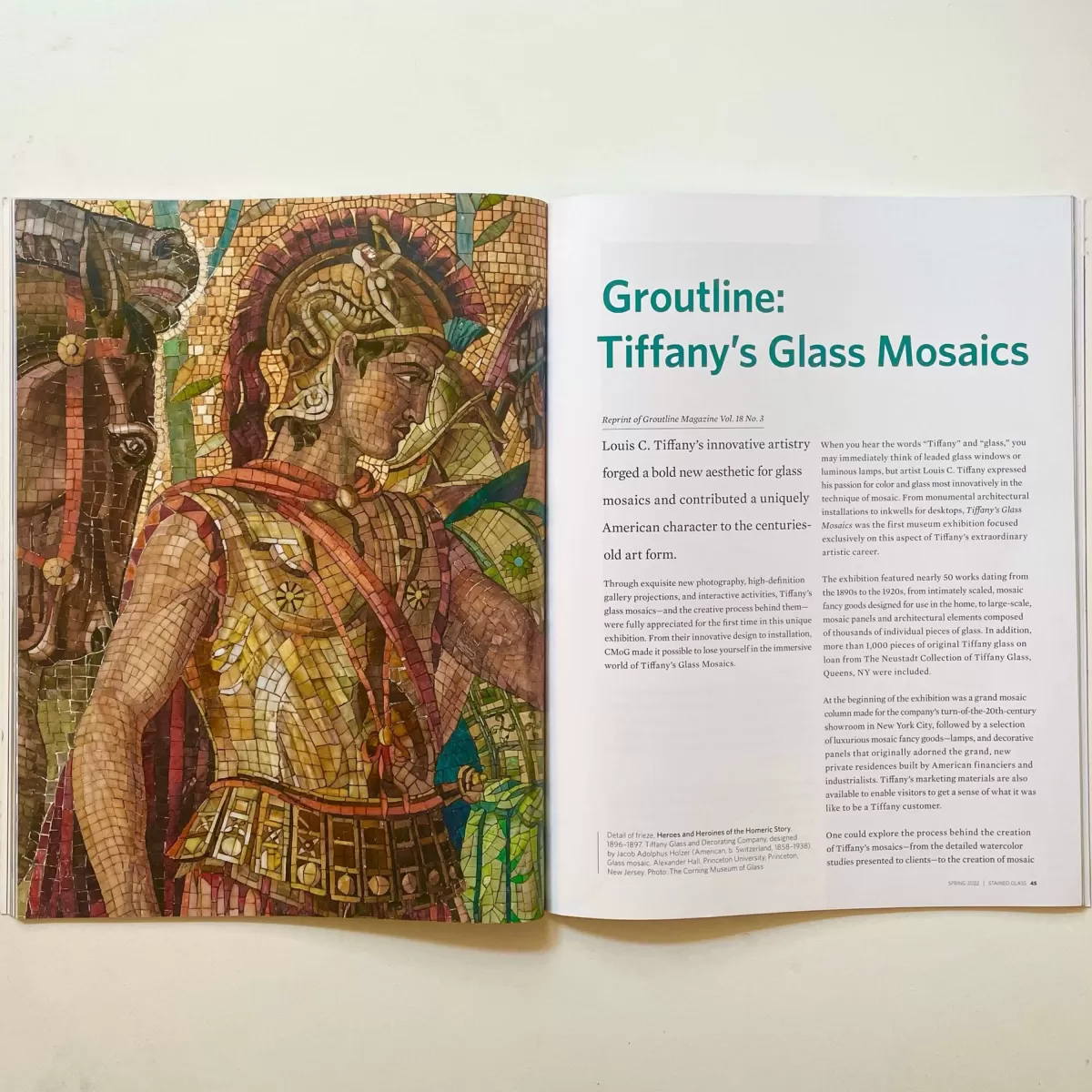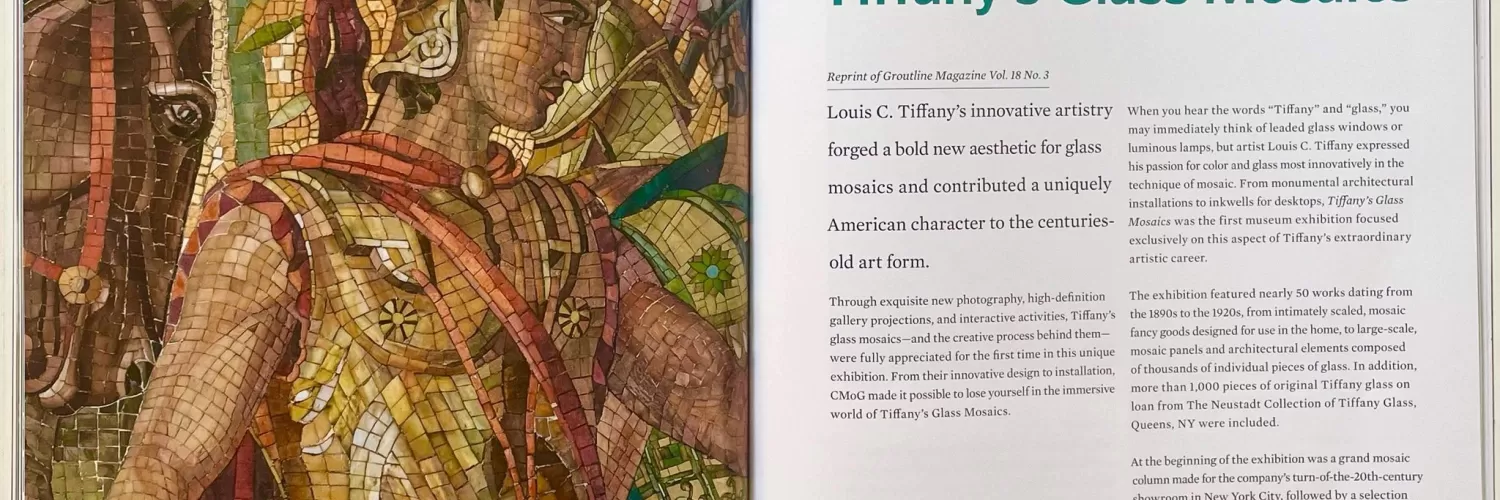Take a look at what you may have missed in our most recent issue of Stained Glass Quarterly!

Editorial
The Editorial Letter from Bryant J. Stranton is available for download (opens new window).
Tribute to Fred Jayson: Reflections from a Grateful Community
By Kennth von Roenn
Fred Jayson’s incredible life is remembered by his dear friend and glass artist Kenneth von Roenn, with additional memories written by those who knew Fred. Fred Jayson was an accomplished musician, successful glassman, and loving family man who, for the one hundred years of his life, brought joy, light, and raw talent to those who were lucky enough to have known him.
“From my 50+ years of working with Bendheim and the Jaysons, I can attest to the very apparent love each of them has for one another, and their shared pride in what they are building, together. This is not by accident: it was initiated, nurtured and sustained by Fred’s leadership example and absolute trust in his sons.
"Fred was much the same way with his friends, nurturing his many friendships with phone calls to stay in touch, on a regular basis. I always looked forward to each of my conversations with Fred. Even though in the past few years he often remarked at how many of his friends were dying, our talks were still filled with his enthusiasm and passion right up until he passed away.
"In talking to so many people, family and friends alike, during the research for this article, I found that we all felt similarly about Fred. Our conversations with him left us all with a smile on our face and gratitude to have had him in our lives.
"How we will all miss him!”
A PDF of the full article is available (opens new window).
How Artist Lynn Basa’s Encaustic Painting Became a Monumental Glasswork
By Alex Davis, Bullseye Glass Co.
Recounting artist Lynn Basa’s collaboration with Bullseye Studios to create a 71’ x 25’ kilnformed glass art piece for Portland’s new Multnomah County Central Courthouse. A true behind-the-scenes look at the details, process of “painting with glass”, and installation of this massive 1700 square foot design.
“The project’s size, budget, and prominent location marked it as an obvious dream job for any public artist. But even though Basa “wrote the book” on public art, she found herself reluctant to apply. The deadline was tight, less than a month away. Not only would she need to figure out how to do right by the project—deciding how her art might activate 2000 square feet of prime wall space in a new county courthouse—she would need to prepare an application able to persuade the artist selection panel to trust her and her vision with $750,000 and Oregon’s most prominent public art opportunity in years. No small task. And then there was the competition. Given the project’s high-profile qualities, it was sure to draw interest from the country’s heaviest hitters in public art. Yet even if those causes for hesitation were thrown aside, Basa still had a fundamental reason to pause: if she applied, she intended to pitch making the artwork out of colored kiln-glass made by Bullseye Glass Company.
"This ambition—to propose creating a work of such size with kilnformed glass—came with its own set of challenges. First, there was the cost. As a unique handmade material that requires multiple phases of skilled production, Bullseye’s artisan kiln-glass costs significantly more than, say, canvas and paint. Second, Basa was not confident the project’s budget could fund her vision, even if she shrank her artist fee by two-thirds. 2000 square feet was a ton of kiln-glass (around eight tons, to be precise). Third, although kilnformed glass has been featured in numerous high-profile public art projects across the world, it remains a relatively undiscovered medium within that sector. As a result, building a proposal around it often carried the risk that the funding organization would not understand the material’s unique appeal for such a project—let alone why that appeal would justify its extra cost. And even within the sophisticated circles of public art administrators, the false impression of glass as fragile can persist.”
Check out the full story here (opens new window)!
Harmonious: Q&A with Amy Valuk
By Maria Pericozzi
The Stained Glass Quarterly Staff sat down with SGAA Amy Valuk to ask how a bench jeweler became a stained glass conservationist. Amy shares the imitate details of glass she witnesses as a conservationist, which she then incorporates into her own designs.
“What I find most satisfying about stained glass is working both two and three dimensionally within the same piece: It’s like a drawing that you build with tools.
"I like to work with pattern, symmetry, and a lot of color, especially when I find those things in unexpected places. That’s why I like flowers so much. They’re orderly, but not exact. At first glance they seem like random shapes but as you look closer they have repeating geometry and an orderly structure. They aren’t exact duplicates, but they follow a general proportion with minor variations from one to the next. When I design a floral window I often do a lot of measuring to lay out a framework for the composition, I then hand draw all of the individual elements within those lines, to give that sense of “same but different.” Your eye reads it as a pattern, even though there are slight variations from one piece to the next. I don’t like making anything where you can use the same pattern to cut multiple pieces of glass.
"Occasionally, I work from plants that are actually growing in my own garden. In those instances, I tend to go with a more organic composition influenced by the growing habit of the plant. If I’m working from photo references, I tend to see a flower more as a graphic motif or scientific specimen, so that translates better into a geometric design.
"My personal work probably falls into two categories: things I make because I have a specific visual image in mind, and things I make in pursuit of an idea about a process, or a problem to solve. The botanical work is always image driven, and usually involves a lot of detailed painting.”
Saara Gallin: A Personal Appreciation
By Ellen Mandelbaum
Glass Artist Ellen Mandelbaum fondly reflects on the work of her lifelong friend Saara Gallin. Saara Gallin’s successful career as a glass artist is attributed to her mantra of “what if?”, taking risks, experimentation, and pushing the limits of what she can achieve.
"Like many of us Saara began her career nowhere near glass. After teaching swimming, she worked in her husband Martin's successful law firm in the south Bronx, one of the poorer sections of New York City. She fell in love with stained glass when she took a hobby class at the Young Men's Hebrew Association (YMHA.) She was off! Later studying with master glass workers Maurice Heaton and Sydney Cash, she learned many techniques that enabled her to make her glass more sculptural. They noticed her talent and gave her the precious gift of personal attention that helped her develop her personal vision.
"Indeed, her process seems alarming. She begins a piece with no drawing, without a cartoon, but makes it up as she goes, inventing 3 dimensional units out of fusing, slumping, who knows what else, and glue. She became an expert at all of them.
"Many of these were major efforts requiring the security of a stable basic structure, often a circular metal frame. She placed her trust in the hands of Mike Vira, a wonderful craftsman who would go on to make her frames and stands and whatever structure was needed. She swears by his skill and is fiercely loyal to him and several others who consistently helped her over the years. Saara worked with Vira to create an intricate fountain for the 2015 American Glass Guild (AGG) exhibit in Washington DC. She publicly credited him and invited him and his wife to the reception to receive appropriate praise. 'Others received her rave reviews, like Steve Halpern who helped her with photography, and all matters digital. She liked to recognize the contributions of those who were often ignored and found depth where you wouldn't expect it. She told me a rule of thumb – when you meet someone – "don't assume you know who they are."
Take a look at the full story (opens new window)!
Groutline: Tiffany’s Glass Mosaics
By Kelly A. Conway and Lindsy R. Parrott
Learn about the glass mosaic work of Louis Comfort TIffany in this Corning Museum of Glass past exhibition. Complete with gorgeous, full color photos of the mosaics, this article highlights some of Tiffany’s most gorgeous and intricate designs, the making of the glass, and the history of mosaics in nineteenth century America. This article was originally printed in the Society of American Mosaic Artist’s Groutline Magazine.
“Louis C. Tiffany’s innovative artistry forged a bold new aesthetic for glass mosaics and contributed a uniquely American character to the centuries-old art form. Through exquisite new photography, high-definition gallery projections, and interactive activities, Tiffany’s glass mosaics—and the creative process behind them—were fully appreciated for the first time in this unique exhibition. From their innovative design to installation, CMoG made it possible to lose yourself in the immersive world of Tiffany’s Glass Mosaics.
"When you hear the words “Tiffany” and “glass,” you may immediately think of leaded glass windows or luminous lamps, but artist Louis C. Tiffany expressed his passion for color and glass most innovatively in the technique of mosaic. From monumental architectural installations to inkwells for desktops, Tiffany’s Glass Mosaics was the first museum exhibition focused exclusively on this aspect of Tiffany’s extraordinary artistic career.
"The exhibition featured nearly 50 works dating from the 1890s to the 1920s, from intimately scaled, mosaic fancy goods designed for use in the home, to large-scale, mosaic panels and architectural elements composed of thousands of individual pieces of glass. In addition, more than 1,000 pieces of original Tiffany glass on loan from The Neustadt Collection of Tiffany Glass, Queens, NY were included.”
Meet New Professional Member: Sunhound Glassworks
By Samantha Flavell
Get to know one of our newest Professional Members, Sunhound Glassworks. With more than forty years of design and restoration under their belt, with high profile notable collaborations such as with Newfoundland’s Basilica Cathedral of St. John the Baptist, Sunhound Glassworks combines tradition with contemporary to make some of the highest quality glass and designs.
“While Brendan admits that he prefers commissions that allow him to do original work and designs, a large portion of his workload also includes restorations of existing pieces, largely those housed in churches.
"In 2020 Sunhound Glassworks was commissioned and completed the restoration of two large stained glass windows in the historic Basilica Cathedral of St. John the Baptist, St. John’s, Newfoundland and Labrador, a designated National Historic Site of Canada. Recently, Sunhound Glassworks also received the commission to restore windows in another historic structure in St. John’s, the Anglican Cathedral of St. John the Baptist.
"One of the challenges Brendan and other stained glass artists are facing is convincing clients to consider and be open to a more abstract piece, which may veer from what some envision as stereotypical stained glass work. “I’d rather be doing my own designs and doing residential stuff or doing contemporary church windows, too. Which is really hard to get,” Brendan said. “It’s hard to convince somebody that something abstract is going to work. Especially if you’re going into a church that already has older style windows.”
"What Brendan has come to realize throughout his time working in stained glass, however, is that each project will be different. Sometimes the designs come easily to mind and other times it is a battle to devise the design in his mind and then get the client on board with what he has envisioned for the window.”
Discovery+ Shines New Spotlight on Stained Glass Makers
By Megan McElfresh
SGAA President David Judson of Judson Studios appeared as a guest judge on the stained glass episode of Meet Your Makers Showdown, a Discovery Plus show series that spotlights artisans who compete in different challenges. Get a behind the scenes look at the production and process of representing stained glass on TV.
“It's always TV magic when it finally premieres but these productions are months and months in the making before we as viewers ever get to enjoy the results. For this series, the work of collecting the tools and equipment started all the way back in Fall 2020. The producers reached out to the Stained Glass Association of America (SGAA), hoping to connect with industry vendors that could help them outfit a staged studio for 4 competitive artists, but carefully giving us no other information about what was in the works.
"Then, in the March of 2021, a call went out asking for applicants to submit background about their artistic story, images and a video. The competitors were selected from those that responded and submitted their work. For all the information requested in the call for artists, the challenge itself felt vague, giving very few details on the show the artists were competing to be selected for. Even here at the SGAA offices, we couldn’t seem to figure out exactly what this new opportunity for stained glass artists really was, even with the tiny bit of additional information we had.
"That secrecy is just business as usual for competitive-TV production and even the four selected were told very little about what was to come, not even knowing travel arrangements until barely a day before they needed to fly out to LA for shooting to begin.”

